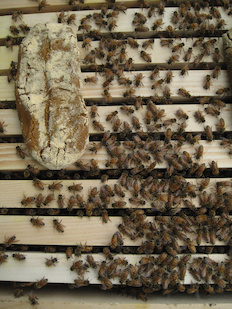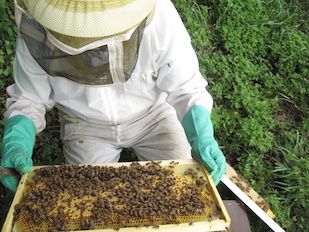Maryland, USA
March 18, 2015

Honey bees were fed with imidacloprid-dosed pollen patties, seen here on the left. Credit: Galen Dively
Colony declines are a major threat to the world's honey bees, as well as the many wild plants and crops the bees pollinate. Among the lineup of possible culprits--including parasites, disease, climate stress and malnutrition--many have pointed the finger squarely at insecticides as a prime suspect. However, a new study from the University of Maryland shows that the world's most common insecticide does not significantly harm honey bee colonies at real-world dosage levels.
The study, which was published March 18, 2015 in the journal PLOS ONE, looked at the effects of the insecticide imidacloprid on honey bee colonies over a three-year period. To see significant negative effects, including a sharp decrease in winter survival rates, the researchers had to expose the colonies to at least four times as much insecticide encountered under normal circumstances. At 20 times the normal exposure levels, the colonies experienced more severe consequences.
The study does not totally absolve imidacloprid of a causative role in honey bee colony declines. Rather, the results indicate that insecticides are but one of many factors causing trouble for the world's honey bee populations.

A member of the research team inspects a honey bee hive to assess the overall health of the colony in response to imidacloprid. Credit: Galen Dively
"Everyone is pointing the finger at these insecticides. If you pull up a search on the Internet, that's practically all anyone is talking about," said Galen Dively, emeritus professor of entomology at UMD and lead author of the study. "This paper says no, it's not the sole cause. It contributes, but there is a bigger picture."
Imidacloprid is one of a broad class of insecticides called neonicotinoids, so named because they are chemically derived from nicotine. In tobacco and other related plants, nicotine acts as a deterrent by poisoning would-be herbivores. While nicotine itself was once used as an insecticide, it has fallen out of favor because it is highly toxic to humans and breaks down rapidly in sunlight. Neonicotinoids have been engineered specifically to address these shortcomings.
"Imidacloprid is the most widely used insecticide in the world. It's not restricted because it is very safe--an order of magnitude safer than organophosphates," Dively said, drawing a comparison with a class of chemicals known to be highly toxic to nearly all living things.
For the study, Dively and his colleagues fed pollen dosed with imidacloprid to honey bee colonies. The team purposely constructed a worst-case scenario, even at lower exposure levels. For example, they fed the colonies tainted food for up to 12 continuous weeks. This is a much longer exposure than bee colonies would experience in real-world scenarios, because most crops do not bloom for such an extended period of time.
Even at these longer exposure periods, realistic dosage levels of imidacloprid did not cause significant effects in the honey bee colonies. Only at higher levels did the colonies start to have trouble producing healthy offspring and surviving through the winter.
"A lot of attention has been paid to neonicotinoids, but there isn't a lot of field data. This study is among the first to address that gap," said Dennis vanEngelsdorp, an assistant professor of entomology at UMD who was not involved in the study. "It's not surprising that higher levels will hurt insects. They're insecticides after all. But this study is saying that neonicotinoids probably aren't the sole culprit at lower, real-world doses."
Dively and vanEngelsdorp both agree that a synergistic combination of many factors is most likely to blame for colony declines. Climate stress could be taking a toll, and malnutrition could be a factor as well. The latter is a particular concern for industrial bee colonies that are rented to large-scale agricultural operations. These bees spend much of their time eating pollen from one or two crops, which throws their diet out of balance.
"Except for the imidacloprid exposure, our test colonies were treated well," said coauthor David Hawthorne, associate professor of entomology at UMD and director of education at the National Socio-Environmental Synthesis Center (SESYNC). "They weren't exposed to additional real-world stressors such as malnourishment or multiple pesticides. Colonies coping with these additional pressures may be more sensitive to imidacloprid."
Dively, Hawthorne and their colleagues found some evidence for at least one synergistic combination. At the highest dosage levels (20 times the realistic dosage) colonies became more susceptible to Varroa mites, parasites that target honey bee colonies. A mite infestation can cause a whole variety of problems, including viral infections and an increased need for other pesticides to control the mites.
"It's a multifactorial issue, with lots of stress factors," Dively said. "Honey bees have a lot of pests and diseases to deal with. Insecticide exposure is one factor among many. It's not the lone villain."
In addition to Dively and Hawthorne, study authors included UMD technician Michael Embrey, Alaa Kamel of the U.S. Environmental Protection Agency and Jeffery Pettis of the U.S. Department of Agriculture.
This research was supported by the USDA-ARS Bee Research Laboratory (Cooperative Agreement No. 58-1275-7-364), the Foundation for the Preservation of Honey Bees, the Maryland Agricultural Experiment Station and the U.S. Environmental Protection Agency. The content of this article does not necessarily reflect the views of these organizations.
The research paper, "Assessment of Chronic Sublethal Effects of Imidacloprid on Honey Bee Colony Health," Galen P. Dively, Michael S. Embrey, Alaa Kamel, David J. Hawthorne and Jeffery S. Pettis, was published online March 18, 2015, in the journal PLOS ONE.